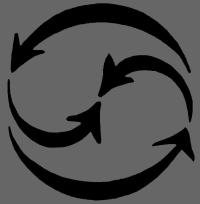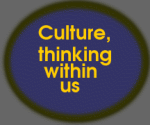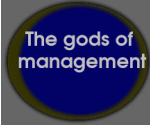This stems from over 40 years' work by
Professor Mary Douglas', joined by many other workers in recent
decades. The existing publications are on the whole written from a
somewhat dry, academic perspective. Also, we may need to adapt the
broad categories somewhat, if we want them to bring light into the
places where we are actually struggling in the day-to-day.
Our initial task will be to delineate our own cultural biases, on the
basis of the conflicts which emerge spontaneously amongst us. This will
also help to break the deadlocks, and careful patterns of
non-communication, which make us ineffective and often docile
participants in the prevailing cultural apathy. I believe that Mary
Douglas' grid and her four "cultural types" will prove to be
indispensable tools for the project of cultural revolution.
The central argument is that there are basic
cultural outlooks which can be found scattered across a wide variety of
cultural contexts, aligning specific sets of issues in surprisingly
stereotyped ways.
EXAMPLES( - but
they will come up later, anyway) This amounts to a limited set of
"thought-worlds" which all of us inhabit, and which make our individual
self-expression far more stereotyped than most of us would like to
think.
In some respects this boils down to a simple set of four cultural
types; however, because these combine and interact in their own
characteristic ways, it makes for a complex spectrum with highly
individual flavours for every distinct sub-culture that we encounter.
Nevertheless, once pointed out, these cultural types are intrusive and
obvious enough for those who are able to recognize them.
EXAMPLES
Thinking that borrows our body, in order to
express itself.
From inside the particular thought-world we are
inhabiting, many things seem completely obvious and we naturally take
them for granted; yet from the perspective of a potential friend who is
outside this thought-world the connections we are making will seem
arbitrary or simply mistaken. There are patterns of thinking which
spontaneously cluster together in very particular ways: to a great
extent they seem to "think themselves" using we humans as their
vehicles.
EXAMPLES
They are in effect self-assembling thought worlds: appearing
self-evident but actually maintained through a mixture of social
reinforcement, habit, and a kind of innate plausibility. As I have
said, they only seem to follow logically while you are inside them; and
they are not at all self-evident to the many people who live under
quite different assumptions.
This is not to discount our personal contribution to the
process of thinking - but we have to recognize that our individual
contributions are merely elaborations out of basic mind-sets which - when we first adopted them - we did so without much of any conscious or personal consideration. Our personal and conscious engagements with all of these matters only comes about later, when we start to reflect upon it all in an emotionally intelligent and dialogical fashion. (The whole of this web-site is really an invitation to such a reflection.)
Mary Douglas first discovered these patterns in
her anthropological work in indigenous cultures. It was only later that
she recognized their striking parallels in a range of cultures and
culture clashes found throughout the modern world.
She and her co-workers have named the four cultural styles:
"hierarchical" (a.k.a. traditionalist), "egalitarian"
(a.k.a.enclavist), "individualist" (a.k.a.enterprise culture) and
"isolate" (a.k.a. excluded, or outcast). Douglas' number and the
characterisation is not arbitrary, but is generated out of the two
parameters of biological obligation, and the sense of group affiliation
which all of us feel in varying degrees in different contexts. (For
more details of this you will need to
consult the
sources.)
EXAMPLES:
The individualist cultural style is in many
parts of the world the most prominent; it has been the rising style in
the "free enterprise" culture of the past 200 years and this makes it
easy to recognize . (Most of us relate to this in the mode of feeling
either an affinity, or a revulsion, towards it.) Individualism
downplays biological obligations and group affiliations; it is largely
anti-traditionalist, and encourages free competition, free thinking and
fluid power bases which wax and wane on the basis of political
manoeuvring and strategic alliance.
There is a typical attitude to nature: that she is bountiful,
resilient, and available for unlimited human exploitation. The
individualist cultural type can also be thought of as a "gang" ethos in
contrast to the "commune" ethos of the egalitarian type. In the modern
and post-modern worlds Individualism has found itself in competition
both with traditional authority and with the egalitarian cultural
style. (Egalitarianism is the other style which claims exclusive rights
to being the way of the future.)
This corresponds to a traditional, pious, and
hierarchical culture in which nature is trusted as a nurturing
container for society on condition she be treated with an appropriate
reverence. The highly complex and social and cultural rules which
everyone is expected to obey without question, are often not perceived
as rules but instead will tend to be felt as the natural order of
things. To a certain extent most of us are secret traditionalists,
insofar as we have our own set of habits, values and outlooks which we
follow without question. We may not recognize how this covertly
situates us within hierarchical forms of organisation.
Here the role positions tend to be very fluid -
because fixed rules are felt to be a violation of the spontaneous
natural order. There is a fierce sense of justice, which is meant to
apply to every person without regard to their position or role in
society. This cultural world often entails a sense of nature as being
dangerously fragile. Life is readily beset by innumerable taboos, such
that we easily become unworthy or unclean through the infraction.
Mary Douglas, from the time of her earliest
research found a correlation between the egalitarian type of
culture and a strong sense of the boundary between the "inside" of the
tribal world and the "outside". The forces outside the tribal nexus are
often perceived as hostile, invasive or impure. Because of the fluid
social roles there is often uncertainty about how one is supposed to
behave; this leads to a high level of misunderstanding and
crossed purpose, which can extend to a ready suspicion of others as
possible carriers of malign influences from "the outside". Sharpness of
the boundary is also a feature of the Hierarchical mode, but in this
latter case the boundary is maintained in a more spontaneous and
habitual way and therefore does not give rise to problems in the same
way.
There are primitive tribes who correspond to
the "Isolate" cultural type; they live in an uncertain world dominated
by environmental instability and often pressure or abuse from
neighbouring cultural groups. Fate and luck (often bad luck) can be
dominating features of the world as it is perceived here.
Unsurprisingly, Nature often appears to be capricious and unfriendly.
This broad cultural outlook is also characteristic of the "underclass"
of many modern and traditional societies - people who are excluded, but
are nevertheless subjected to the pressures, the rules and the laws
exerted by other social groups.
The "isolate" type includes a wealth of
variation
As a result of my extensive study of Charlotte
Bach's theories of cultural evolution, I am inclined to include within
the "isolate" type a whole spectrum of paradoxical individuals:
criminals, addicts, lunatics, artistic geniuses, shamans and religious
visionaries. Many of these people are disguised as relatively normal
members of another, host culture. Or as artists or leaders they may be
granted a fragile honorary status by the majority. This high status is
as easily snatched away as it is granted; it can also be conferred
posthumously.
In a remarkable corroboration of Mary Douglas'
theory, Charles Handy (in The Gods of Management) has distinguished
four strongly contrasted management styles. Their different
personalities are of such archetypal clarity that he was moved to name
them after Greek Gods: Zeus, Athena, Appolo and Dionysus. It is
possible that Handy had some prior acquaintance with Mary Douglas' work
(I shall have to find out from him), but his account is so powerfully
infused with his own experience of the business and management worlds
it makes me think he may well have developed his concepts largely (perhaps
completely) independently of Douglas.
ZEUS
Zeus is the organisational culture centred on
the strong authority of one man, but often in a relaxed "club"
environment where everyone knows their role and how to function - and
is allowed maximum autonomy within the limits of "how the boss would
like things to be". Recruitment is often through the extended family
network, or the Old School Tie - informal and based on whether or not
the boss feels you would "fit in".
ATHENA
Athena is the flexible, egalitarian work group
which typically thrives on limited, small assignments where
adaptability to new conditions is at a premium; the group thrives on
the willingness of each individual to use their talents in committed
and flexible ways to meet the constantly shifting contour of the task
at hand.
APPOLO
- The Appolonian organisation is perfectly
regulated, highly differentiated and hierarchical. It is perfectly
adapted to a demanding but stable environment where standard procedures
can be evolved and tailored to the prevailing circumstances. In such an
environment a large-scale highly organised operation has an
irresistible competitive advantage. This is how IBM and General Motors
used to be in their heyday. It is a world that appeals to people who
like plenty of order in their lives, a well defined place with
predictable pathways to self-advancement and a task profile which
remains constant through time.
DIONYSUS
Dionysus is the maverick genius, the talent
who is irreplaceable and can therefore force the organisation to accept
his/her contribution on his/her own terms. Dionysus makes his own
rules, and is free to break even these whenever he feels like it. He
does not fit into the team, and - appearing a bit strange and
untrustworthy - would be excluded from the organisation altogether if
they thought they could do without him.

They are probably all inter-dependent really
Handy's work also emphasises that none of these
styles succeeds in maintaining a perfect equilibrium within a modern,
pluralistic environment. Each organisational style has its own
particular strengths and weaknesses - and in the long term each helps
to create an environment which contains hospitable niches for the
advance and empowerment of one or more of the others. A similar kind of
cycling process has also been described by Mary Douglas and her
co-workers in the evolution of cultures in a complex environment.
Additional thoughts
I have noticed that individual thinkers often
break the predominant cultural mode, and may in fact be initiating
major shifts in outlook by introducing - to take one example - an
egalitarian strand of thought within a predominantly hierarchical
world-view (I am thinking here of the philosopher Immanuel Kant). I
also think that scientific innovations have caused major fractures in
our cultural outlook over the past several centuries; it may be that
the free speculation and testing of scientific hypotheses is a major
cultural force in its own right - not corresponding very clearly to any
one of the four main types. (The archetypal "mad scientist" is clearly
a Dionysan kind of character, however.)
My interest here, in any case, is to initiate a
new cultural practice in the form of
action research which we can
practice in small groups. We will aim to forge a different bond of
loyalty through a more open expression of our cultural identities
whilst encouraging the disjunctions and discontinuities between us to
emerge and come into focus. This is more fully discussed
elsewhere on
this site.
Mary Douglas first published book
Purity
and Danger(1966) explores the subtle aspects of the lifestyle of a
traditional society, the Lele people of what was then called the
Belgian Congo. Only many years later did she come to see this as one
"type" in a relatively simple pattern of differentiation between four
main cultural types or styles. (Under this taxonomy, the Lele would be counted as "egalitarian" in type.) In her introduction to
How
Institutions Think(Syracuse UP, 1986) Professor Douglas suggests
that this book should
logically precede her previous four.
This is because, read in the reverse order from which she wrote them,
they represent a natural unfolding and detailing of the essential
concept of cultural styles.
Other useful references:-
Mary Douglas
Risk and Culture
Natural Symbols
Michael Thompson, Richard Ellis, and Aaron Wildavsky: Cultural
Theory 1990
S.H.Heap & A.Ross (eds.) Understanding the Enterprise
Culture
| Try pressing the "back" button on your browser to
return to where you were |
return to the top |
 |
© all content: copyright reserved,
Michael Roth, March 2009 |
|










